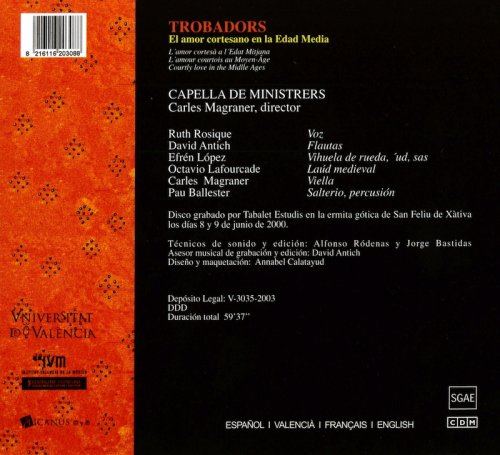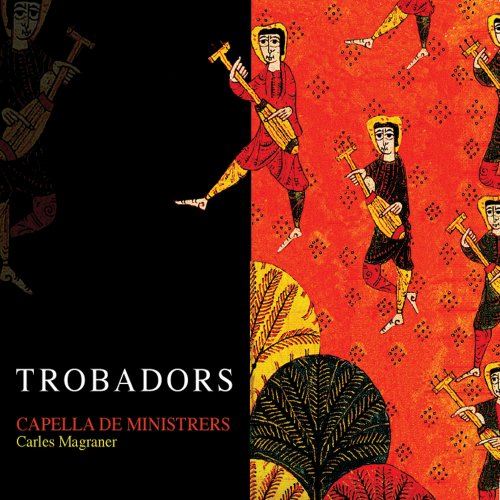
Capella De Ministrers, Carles Magraner - Trobadors (2003)
BAND/ARTIST: Capella De Ministrers, Carles Magraner
- Title: Trobadors
- Year Of Release: 2023
- Label: CDM
- Genre: Classical
- Quality: flac lossless (tracks)
- Total Time: 00:59:39
- Total Size: 322 mb
- WebSite: Album Preview
Tracklist
01. Aras pot hom conoisser e proar (Instrumental)
02. Ben volgrà
03. S'anc vos ame
04. Savis e fols, humils et ergulhos
05. En greus pantais
06. Amors, mercé no sia
07. A Tantas bonas chansos
08. S'ieu fos en cort
09. Dona, la ienser
10. Kalenda maya
11. Aital dona
12. Reis glorios
13. Can vei la lauzeta mover
14. Jes per temps
15. Aras pot hom conoisser e proar
16. Tant es gay
17. Guerras ni platz no son bos
18. No magrad'iverns
19. Un sirventesc novel
20. De la iensor
21. Atressi cum la candela
22. Tant m'abelis

Troubadours were musician poets who developed their activities mainly in France during the 12th and 13th centuries. They combined music and poetry at the service of the ideals of the court. This is a passionate monographic approach to troubadour art, which wisely combines a scholarly historical treatment of the music with a lively rendering of the troubadour are that takes us to the heart of the Middle Ages, rendering this music as if it were composed today.
The poetic and musical universe of the troubadours constitutes one of the most refined and sophisticated cultural legacies of medieval Europe. Exquisite in its forms, openly innovative in its approaches, the troubadour art traversed like a trail of light all the western European Courts during the XII and XIII centuries. Few monarchs and nobles resisted his subtle words and his beautiful love songs. In Castile, King Alfonso VIII, the Navas de Tolosa, was a troubadour, perhaps influenced by his wife, Leonor de Plantagenet; and so was Alfonso X the Wise, the great troubadour of the Virgin Mary. In the Crown of Aragon, on the other hand, the political and commercial relations allowed, perhaps, a greater permeability of the cultural flows of Occitania in the royal courts. The work of troubadours as well known as Raimbaut de Vaqeiras, Bernart de Ventadorn, Berenguer de Palou, Giraut de Boirnelh, Pere Raimon de Toloza or Peire Vidal know that she was known and admired by Pedro II, Jaime I, Alfonso III or Jaime II.
It is very difficult today to try to recreate that musical and cultural environment. To the difficulties of the scarcity of sources for its study, we must add the problems that the mensural notation in which this repertoire is copied poses at the time of a rigorous musical interpretation. Therefore, addressing it with guarantees of success is a privilege reserved for a few. Trobadors, the latest release of Magraner and its Ministrers Chapel for its namesake label, CDM, is an exciting journey through the work and music of some of these troubadours. Rigorous in his approach, refined in his interpretations, Magraner manages to evoke with undoubted mastery the subtle and idyllic atmosphere of this evocative and mysterious poetry. The musical recreation in charge of an envelope Ruth Rosique and a select group of minstrels with names as well known as those of Magraner himself la viella, Octavio Lafourcade in the medieval lute or David Antich in the flutes is admirable from the musicological point of view and, also, artistic. An exciting album.
01. Aras pot hom conoisser e proar (Instrumental)
02. Ben volgrà
03. S'anc vos ame
04. Savis e fols, humils et ergulhos
05. En greus pantais
06. Amors, mercé no sia
07. A Tantas bonas chansos
08. S'ieu fos en cort
09. Dona, la ienser
10. Kalenda maya
11. Aital dona
12. Reis glorios
13. Can vei la lauzeta mover
14. Jes per temps
15. Aras pot hom conoisser e proar
16. Tant es gay
17. Guerras ni platz no son bos
18. No magrad'iverns
19. Un sirventesc novel
20. De la iensor
21. Atressi cum la candela
22. Tant m'abelis

Troubadours were musician poets who developed their activities mainly in France during the 12th and 13th centuries. They combined music and poetry at the service of the ideals of the court. This is a passionate monographic approach to troubadour art, which wisely combines a scholarly historical treatment of the music with a lively rendering of the troubadour are that takes us to the heart of the Middle Ages, rendering this music as if it were composed today.
The poetic and musical universe of the troubadours constitutes one of the most refined and sophisticated cultural legacies of medieval Europe. Exquisite in its forms, openly innovative in its approaches, the troubadour art traversed like a trail of light all the western European Courts during the XII and XIII centuries. Few monarchs and nobles resisted his subtle words and his beautiful love songs. In Castile, King Alfonso VIII, the Navas de Tolosa, was a troubadour, perhaps influenced by his wife, Leonor de Plantagenet; and so was Alfonso X the Wise, the great troubadour of the Virgin Mary. In the Crown of Aragon, on the other hand, the political and commercial relations allowed, perhaps, a greater permeability of the cultural flows of Occitania in the royal courts. The work of troubadours as well known as Raimbaut de Vaqeiras, Bernart de Ventadorn, Berenguer de Palou, Giraut de Boirnelh, Pere Raimon de Toloza or Peire Vidal know that she was known and admired by Pedro II, Jaime I, Alfonso III or Jaime II.
It is very difficult today to try to recreate that musical and cultural environment. To the difficulties of the scarcity of sources for its study, we must add the problems that the mensural notation in which this repertoire is copied poses at the time of a rigorous musical interpretation. Therefore, addressing it with guarantees of success is a privilege reserved for a few. Trobadors, the latest release of Magraner and its Ministrers Chapel for its namesake label, CDM, is an exciting journey through the work and music of some of these troubadours. Rigorous in his approach, refined in his interpretations, Magraner manages to evoke with undoubted mastery the subtle and idyllic atmosphere of this evocative and mysterious poetry. The musical recreation in charge of an envelope Ruth Rosique and a select group of minstrels with names as well known as those of Magraner himself la viella, Octavio Lafourcade in the medieval lute or David Antich in the flutes is admirable from the musicological point of view and, also, artistic. An exciting album.
As a ISRA.CLOUD's PREMIUM member you will have the following benefits:
- Unlimited high speed downloads
- Download directly without waiting time
- Unlimited parallel downloads
- Support for download accelerators
- No advertising
- Resume broken downloads


